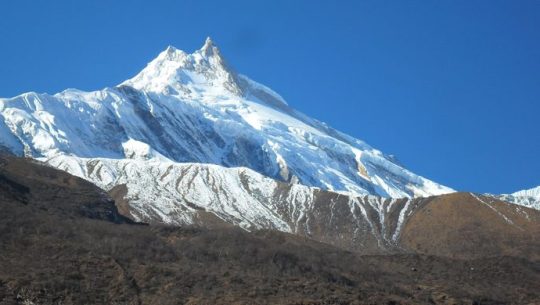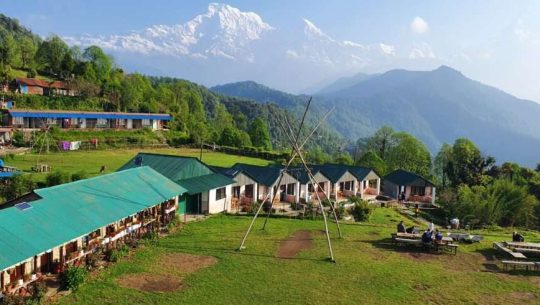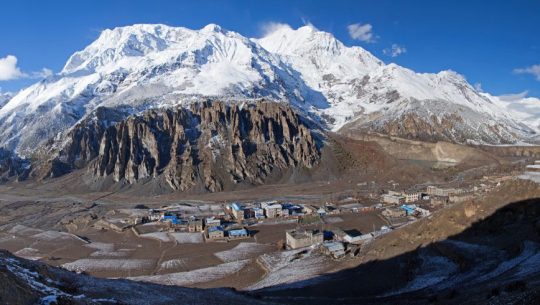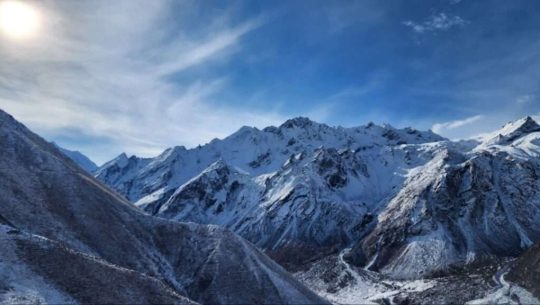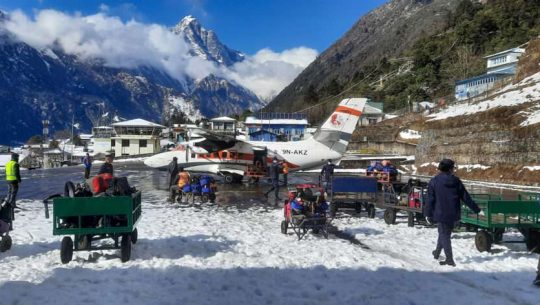Nepal is a popular destination for travel and tourism because of its Himalayas and cultural diversity. In addition, guests traveling to Nepal view tasting a variety of Typical Nepali cuisine as an extremely significant and memorable experience.
Nepal’s distinct cuisine reflects the diverse practices and cultures of the Nepalese people. Because indigenous herbs and spices are used, Nepalese food is highly nutritious, healthy, and flavorful.
Nepali Cuisine List
1. Thakali Cuisine
Thakali cuisine uses locally grown buckwheat, barley, millet, and dal, as well as rice, maize, and dal imported from lower regions to the south. Grain may be ground and boiled into a thick porridge that is eaten in place of rice with dal. A kind of dal is even made from dried, ground buckwheat leaves.
Ghoken (phaparko roti):
Buckwheat flour roti.
Sangdhen (dhindo):
Thick porridge-like dish made from buckwheat or millet flour.
Kalo maas/Mustang simiko daal:
Thick soup prepared from black lentils or local beans, seasoned with ghee and jambu.
Thakali khana:
Thakali main meal often consists of buckwheat dhindo instead of rice, and daal made from either black lentils or local beans.
Alangkhu:
Hand-torn buckwheat flour dumpling/noodle soup with smoke-dried mest, fresh greens, and radish.
Rasya (bhutuwa):
Mountain goat, sheep, or yak offal fried with spices.
Tyasyakhu:
Soup is made from a mountain goat’s head and legs, and a few key spices like timmur, chilli, garlic, and salt.
Lepukhu:
Spicy and sour soup made from mountain goat head, including brain.
Pharokhu:
Soup prepared from roasted white bean flour.
Dhoprakhu:
Traditional soup prepared from dried buckwheat greens powder.
Kaprakhu:
Barley soup.
Dhong/Ghinti:
Thakali blood sausage is made from sheep, mountain goats, or yak blood and offal, and sometimes with buckwheat flour.
Taya (aalu) dameko:
Halved potato fried slowly in ghee on a pan over low heat.
Sukuti:
Smoke-dried mountain goat, sheep, or yak meat.
Kanchemba:
Crispy buckwheat fries. usually served with garlic-chili achaar or timmurko chhop.
Taya (aalu) sukuti pla:
Curry is made from potato and smoke-dried meat flavored with ghee and jimbu.
Timmurko chhop:
Dry spice mixture of timmur, red chill, and Himalayan rock salt.
Thepe:
Achaar is made from smashed radish with spices and timmur.
Phopke:
Fermented rice dessert with ghee and sugar.
Jhaikhatte:
Distilled barley or naked barley alcohol with rice grain tempered in ghee.
2. Khas Cuisine
Dal-bhat-tarkari is the typical meal that the Khas people traditionally eat twice daily. However, other grains supplement or even take the lead because there is a lack of land suitable for irrigated rice paddies. Wheat is transformed into unleavened roti or chapati bread.
Khir:
Sweet rice of tapioca pudding cooked in milk with spices and nuts, prepared during festivals and ceremonies.
Dhakani:
Sweet rice pudding prepared by cooking, an aromatie rice variety in ghee and milk.
Khichadi:
Savory black lentil and rice porridge cooked with ginger and ghee, and eaten during the Maghe Sankranti festival,
Dupka:
Thick soup curry made of black lentils or horse gram paste dumplings, the most popular food of the far-western region of Nepal.
Puwa:
A sweet dish prepared by frying rice flour or grits in ghee and sugar.
Chamre and Latte:
Sticky or aromatic rice cooked in ghee and sugar. Chamre is prepared from an aromatic rice variety and a latte is from a sticky rice variety.
Both are eaten during the Poush Pandhra festival.
Batuk and Fulaura:
Deep-fried black lentil patties are prepared during the Maghe Sankranti festival; Batuk is ring-shaped while fulaura is a round ball.
Chhach batuk:
Batuk (deep-fried black lentil patties) in buttermilk flavored with spices; consumed by the Khas community in the far-west.
Fini roti:
Crispy deep-fried layered pastry prepared from wheat flour and ghee.
Selroti:
Deep-fried ring-shaped confection or roti prepared from rice flour batter and ghee.
Khude roti/Arsa:
Deep-fried sweet roti prepared from rice flour and sugarcane molasses.
Puri:
Deep-fried rice or wheat flour roti is made especially during religious ceremonies and festivals. In the far-west, it is often filled with cooked lentil paste.
Makaiko roti:
Unleavened maize flour roti is often cooked in Banana/Sal/Chiuri leaves.
3. Newari Cuisine
A subset of Nepalese cuisine originated among the Newars of Kathmandu (Kathmandu is called Yen in Nepal Bhasa) in Nepal and is referred to as Newa cuisine (also known as Newar cuisine). The country’s most well-known cuisine, which includes more than 200 dishes, is Newa cuisine. Because the Kathmandu Valley has enough wealthy households and exceptionally fertile alluvial soil to make growing produce more profitable than cultivating rice and other staples, it is more elaborate than the majority of Nepalese cuisine.
Chhoyla:
Buffalo meat, barbecued over rice straw flame and mixed with spices and roasted mustard oil.
Baji:
Flat crispy has beaten rice flakes
Gwaramari:
Savoury deep-fried balls are prepared from lightly fermented wheat flour dough.
Yomari:
Sweet steamed rice flour confection/cake typically with sesame seeds and chaku Goggery taffy) filling.
Lonchamari:
Steamed rice flour and sugar mixed dough.
Lakhamari:
Deep-fried sweets made from rice and lentil flour, sugar, and ghee.
Wo:
Savory lentil pancakes, sometimes topped with minced meat and/or egg sometimes topped with minced flour vegeta Bieacandati, and/or
Chatamari:
Thin crispy savory rice egg- meat,
Momo/Momocha:
Steamed dumplings filled with minced meat and spices, typically served with tomato achaar.
Dyagula:
Buff stew with aromatic spices.
Meekwa:
Fenugreek seeds and small field peas soup. (rice wine) and buffalo bones,
Bula/Kakwa:
Stew is prepared from cartilage, tapering dregs of thwon bone marrow.
Aalu Chhon (Aalu-tama):
Tangy and eyed beans with potatoes and tama (fermented bamboo shoots) soup
Paunkwa:
Thick sour and spicy soup prepared from lapsi.
Kwanti:
Soup prepared traditionally from mixed sprouted beans and lentils, Bhyata ken: Winter curry of sun-dried broad-leaf mustard greens, soybeans, and rice grits.
Aalu wala:
Boiled potato salad or achaar mixed with spices.
Musya wala:
Roasted soybeans mixed with spices and head meat.
Buffalo Sanyakhuna:
for several Gelatinous hours dish (the Li iS by prepared cooking by the adding leg Takha and smoked fish, chili powder, and citrus juice)
Kachila:
Raw minced buffalo roasted meat mustard with oil. ginger, garlic, chili, salt, and spice
Janla:
Raw tender buffalo skin mixed with spices.
Chohi:
Steamed cake made buffalo from the blood and clear bone liquid that marrow. has been separated from
Sapumicha:
Deep-fried tripe stuffed with bone marrow eaten during festivals.
Samay-baji:
An important religious and cultural platter celebration consisting of a set of food items: baji, WO, chhoyla, aalu wala, musya wala, khen (boiled egg), Sanya (smoked fish), waucha (stir-fried greens).
Dhau:
Yogurt.
Thwon:
Rice wine (sometimes prepared from beaten rice). Hyaun thwon is red color fermented rice wine, sometimes flavored with roasted green chiles.
Aila:
Distilled hard liquor extracted from fermented rice.
4. Magar and Gurung Cuisine
The Gurungs consume buffalo meat but not pork, whereas the Magar do not consume water buffalo. This is a sans-sugar dish made with wheat, corn, and dried green vegetables, it is an extremely famous dish among Nepalese. Potatoes, bamboo shoots, and curry are used to season this popular traditional dish.
Dhindo (Paigo):
Thick porridge-like dish prepared from millet or buckwheat flour; of a traditional staple of the Magar and Gurung Gurung communities.
Aanto:
Maize grits cooked as rice.
Kodoko roti:
Millet flour pancake.
Batuk:
Deep-fried black lentil patties (sometimes prepared from ricebeans); an essential cultural food of the Magar community required in festivals and marriage ceremnonies.
Selroti:
Deep fried ring-shaped confection or roti prepared from rice flour batter and ghee.
Jhilinge roti:
Roti made by pressing a cooked rice paste into thin stringy noodles, which are then a sun-dried and later consumed by deep-frying, a festive delicacy of the Gurungs.
Gundruk ra bhatamasko jhol/tihun:
Dried fermented greens and soybean soup or curry.
Niguroko tihun:
Fiddlehead fern curry.
Sisnuko khole:
Nettle greens soup.
Usineko tarul:
Boiled yam usually eaten as a snack with a chilli- salt paste.
Karelako achaar:
Bitter gourd achaar with sesame seed grounds and spices.
Sukako karkaloko achaar:
Dried taro stem made into sour, spicy achaar.
Waksya:
Local black hog meat curry.
Sukuti:
Smoke-dried meat.
Jaand ra raksi (Paa):
Alcoholic drink prepared by fermenting millet, sometimes with maize and wheat; an integral cultural drink of the Magars and Gurungs.
5. Sherpa, Tamang, and Tibetian Cuisine
In Nepal, you can find restaurants that serve Sherpa, Tamang, and Tibetan cuisine in major cities such as Kathmandu and Pokhara. These cuisines are not only delicious but also offer a unique insight into the cultures and traditions of Nepal’s diverse ethnic groups.
Kur:
Thick unleavened bread or roti made from wheat or barley flour.
Syan/Sen:
Thick porridge like dish made from millet, barley, buckwheat, or wheat flour.
Rikikur:
Potato pancake/roti traditionally served with nak butter and saucelachaar made from fresh precipitated buttermilk dregs ‘serkam’ or fermented serkom.
Babar:
Deep festive fried plain delicacy roti of made the from Tamang rice and of buckwheat flour batter, a traditional Hyolmo communities.
Alum:
Steamed millet flour dough, a common Tamnang dish.
Fulaura:
Deep-fried buckwheat flour balls.
Shaphale/Shabhalep:
Deep-fried pastry filled with minced meat, spring onion, and spices.
Shyakpa/Thenthuk:
Typical Sherpa and Tibetan hand-torn noodle soup with meat, potato, radish, and greens.
Thukpa:
Noodle soup with meat and/or vegetables.
Momo:
Dumplings flled with minced meat mixed with spices.
Rilduk:
Hearty soup made from mashed-pounded potato dumplings.
Phalgi:
Winter stew of steamed and then dried unripe maize kernels, often with beans, meat, potato, radish, and carrot.
Guthuk:
Stew made from nine ingredients eaten on the eve of Lhosar as a festive meal.
Tsampa:
Roasted barley or naked-barley flour eaten with butter tea or milk.
Tingmo:
Fluffy steamed bun made from wheat flour.
Lhaphing:
Tibetan spicy and savoury cold noodle (originaly a northern Chinese dish known as liangfen).
Gyuma:
Blood sausage prepared with minced meat Including offal) of a yak, sheep, or mountain goat, and sometimes including rice or tsampa, and encased in intestines.
Goyang:
Fermented leaves of wild edible brassica plant.
Chhurpi:
Hard cheese made from yak milk.
Serkam:
Buttermilk dregs or whey.
Somar and Shosim:
Fermented buttermilk dregs and milk cream, respectively.
Chengkol:
Fermented barley or naked-barley alcoholic drink mixed with tsampa, butter, sugar, egg, and nuts.
6. Tharu and Maithili Cuisine
Both Tharu and Maithili cuisine has a strong emphasis on using locally available ingredients and traditional cooking methods. These cuisines are also influenced by the neighboring cuisines of India and Nepal.
Dhikri:
Steamed rice flour dough, a festive delicacy of the Tharus living in the western plains.
Bagiya:
Similar dhikri but diamond shaped and often with a filling of cooked legumes, or potatoes mixed with spices, a festive delicacy of the Tharu and Maithili community in the eastern plains.
Bhakka:
Fluffy steamed rice flour cake, a popular dish of the Rajbansi community in the eastern region.
Chichar:
Steamed anadi rice, a traditional variety of sticky rice grown in the western region.
Poka:
Chichar wrapped in a leaf and roasted over embers or hot ash.
Ghonghi:
Freshwater snail curry, popular among both the Tharu and Maithil comnmunities.
Pakuwa:
Dry- cooked meat of pork, wild boar, pigeon, or chicken with spices
Katnausi:
Meat of a pig, wild boar, or goat meat cooked together with its blood and spices.
Gengta/Kakhor/Kekhada:
Small freshwater crabs cooked or fried together with spices.
Jhingiya machhari:
machhari; Freshwater reshwvete shrimp stir -fried together with spices.
Sipi/Situwa/Sutahi:
Freshwater mussels, which are boiled first, their shells removed and cooked as a curry.
Patushni/Arikanchan/Khariya:
A dish prepared from layers of taro leaves pasted with rice flour or or legumes paste.
Sidharaa:
Sun-dried ground taro stems and small dried fish cake or patties, cooked as a curry or soup.
Biriya:
Withered greens mixed sun-dried, and eaten lngocep with rice or fried or as a curry.
Bayarak chutney:
Spicy, sweet, and sour chutney made from bayar (wild Indian plum).
Sidhrak chutney:
Chutney made from small dried fish and spices.
Tilauri (Tilke laddu):
Small round- shaped festive sweets made from sesame seeds and jaggery.
Teli paur roti:
Deep-fried roti made from rice flour batter, an essential food item during marriage ceremonies.
Aandik jhor/Jaar:
Traditional alcoholi beverages made from a sticky rice variety known as andik or anadi.
Mahuwa:
Liquor made from wild flowers called mahuwa.
Khichari:
Commonly eaten delicacy prepared by cooking rice and lentils together with ghee and spices.
Choka/Bharta:
Mashed roasted or boiled potatoes, brinjals, elephant foot yams with spices.
Chana daal puri:
Pan-fried puri (roti) stuffed with cooked split gram and spices.
Machhka jhor:
Fish curry usually cooked with mustard seed paste and spices.
Rohu fish, a carp variety, is the most popular.
Kadhi-badi:
Deep-fried gram flour dumplings and yoghurt curry or soup
Adaurike tarkari:
Sun-dried legume nugget curry
Taruwa:
Deep-fried potatoes and vegetables dipped in gram or rice flour batter.
Aalu bhujiya:
Thinly-cut potatoes pan-fried to crisp.
Gujiya:
Deep-fried sweet pastry flled with khuwa.
Thekuwa:
Traditional sweet deep-fried cookies prepared with whole wheat flour, jaggery, milk, and ghee.
7.Rai and Limbu Cuisine
Both Rai and Limbu cuisines are influenced by the geography and climate of the region, as well as the availability of local ingredients. They are an important part of Nepali cuisine and offer a unique taste of the country’s diverse culinary heritage.
Chamre:
Rice is cooked slowly in mustard oil or ghee, turmeric powder, cumin seeds, fenugreek seeds, and salt.
Dhindo/Mangtak:
Thick plain porridge-like made from millet or buckwheat flour, and sometimes with maize and wheat flour.
Chyankhlako Bhat:
Cooked maize grits.
Kharen:
Millet, maize, or wheat flour roti.
Sigolya/Pengoyla:
Steamed barley or millet flour dough.
Papanda:
Millet flour dough wrapped leaves and roasted on an open fire.
Wachipa/Wamyuk/Wamrik/Tite:
Special traditional dish prepared from cooking rice, minced rooster meat including offal with inner feather ash.
Selroti:
Deep-fried ring-shaped roti made from rice flour batter and ghee.
Gormali:
Sweet pudding made from milk and wheat flour dumplings, somnetires including rice; a common dish among the Sunuwar, one of the Kirat communities.
Kinema/Chembighik/lmbringgik:
Fermented soybeans, usually cooked into a curry or soup.
Yangben phaksa:
Pork curry with wild edible lichen and pig blood.
Sagi/Sigwa/Sasungi sumbak:
Curry or thick soup prepared from tender leaves or tips and flowers of nettle greens.
Phando sumbak:
Simple soup made from roasted soybean flour.
Phaksa-nudhi sumbak:
Pork curry cooked with broad leaf mustard greens (rayo saag).
Sargemba/ Sargyangma:
Blood sausage made from pig blood and minced pork, often with offal and wild lichen encased in a pig’s intestines.
Lungghakcha:
Unripe maize paste steamed by wrapping in its husk
Gundruk:
Fermented broadleaf mustard or radish greens
Chhop achaar:
Dry powdered achaar prepared from oila seeds such as niger seeds (philinge)
Pumpkin seeds, with:
salt, spices, and concentrated lemon Juice (chuk).
Singki:
Fermented shredded radish.
Mesu/ Phesuppa:
Fermented bamboo shoot achaar.
Tongba:
Alcoholic drink made from fermented millet served in a cylindrical-shaped vessel called tongba, with hot water.
Thi (jand):
Undistilled alcoholic drink prepared by fermenting millet grains, and sometimes from maize, wheat, etc.
Sijungwa (raksi):
Distilled alcohol is usually made from fermented millet.
Nepal Food Testing Tour
Nepal, known for its geographical, ecological, and ethnic diversity, offers a rich tapestry of unique dishes. Kathmandu, the bustling capital, serves as a melting pot of cultures, providing a diverse culinary experience. The tour explores the city’s food culture, showcasing the integral role of food in Nepali lifestyle and celebrations.
Itinerary:
Day 1: Nepali Cuisine
- Arrival in Kathmandu, transfer to the hotel.
- Evening: Traditional Thakali khana tasting, an improvised version of daal-bhaat, featuring rice or dhindo, gundruk, and various extras.
- Overnight stay at Hotel in Thamel.
Day 2: Momos & Roti/Naan-Tandoori
- Morning pick-up by tour guide.
- To visit the Patan Durbar Square and test the Halacha, Newari Family food Brand.
- Then go to Hotel Chhemiki to prepare MoMo with a local cook, the lovely owner of this hotel, and a Guide
- Momos tasting is a popular Nepali dumpling with various forms like steamed, fried, kothey, chilly, and jhol.
- Evening: Roti and Naan-Tandoori chicken/sekuwa tasting.
- Overnight stay at Hotel in Thamel.
Day 3: Newari Food in Kirtipur and Patan
- Morning drive to Kirtipur for a taste of traditional Newari cuisine.
- Visit Bagbhairab, Chilancho Mahabihar, and Umamaheshwor Temple over there.
- Sampling Newari delicacies such as Chatamari, Choila, Kunya, Bara, Gwaramari, and Samay Baji.
- Visit Chobhar Hill and on the way visit Swyambhunath Stupa.
- Overnight stay at Hotel in Thamel.
Day 4: Tibetan Food in Boudha & Juju Dhau in Bhaktapur
- Exploration of Boudha, known for its Tibetan food, including Laphing, Khapse, Thukpa, Thentuk, and Shaphaly.
- Then go to Purano Thimi to observe the Clay pot production area then go to Bhaktapur Durbar Square.
- Visit Bhaktapur to taste Juju Dhau, a famous local curd.
- Overnight stay at Hotel in Thamel.
Day 5: Local Food Touring & Departure
- Stroll through different food stalls for local food touring.
- Visiting local city tours in Kathmandu including Ashan, Indrachor, Kathmandu Durbar Square
- Tasting Lassi at Indra Chowk, Samosas at Tiptop, and various desserts.
- Explore local areas for souvenirs and gifts.
- Evening transfer to the airport, concluding the Nepal Food Tasting Tour.
POPULAR PACKAGES

